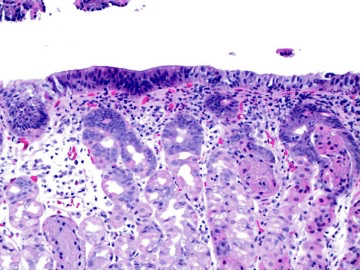Sunday Poster Session
Category: Stomach and Spleen
P2128 - Collagenous Gastritis: A Rare Disease With an Unusual Presentation
Sunday, October 26, 2025
3:30 PM - 7:00 PM PDT
Location: Exhibit Hall

Carla Erb, DO
AU/UGA Medical Partnership
Athens, GA
Presenting Author(s)
Carla Erb, DO1, Robert Graham. Ferguson, MD, MPH1, Vinod Jeyaretnam, DO1, Asif Qadri, MD2
1AU/UGA Medical Partnership, Athens, GA; 2Athens Digesstive Healthcare Associates, Watkinsville, GA
Introduction: Collagenous gastritis (CG) is a rare disorder with recent literature suggesting a incidence of 13 per 100,000 endoscopies. It is characterized by subepithelial collagen deposits and inflammatory infiltrates in the lamina propria, and is diagnosed with endoscopic biopsies. The etiology is unknown, and affects both the adult and pediatric populations. In adults, it typically presents with nonspecific symptoms such as diarrhea, anemia, and abdominal pain. Due to the rarity of the disease, there is no standard therapy and trials with therapies such as proton pump inhibitors or H2-receptor antagonists have shown little success. Recent studies suggest improvement with topically targeted budesonide (TTB), but more research is needed.
Case Description/
Methods: This is the case of a 21-year-old male who presented to the gastroenterology clinic with a 5-year history of reflux. Additional symptoms included intermittent nausea, and bright red blood per rectum, without diarrhea or constipation. Initial workup, including H pylori, celiac panel, hepatitis panel, GI pathogen stool studies was negative. He underwent gallbladder imaging, which was also unrevealing. Patient was trialed on omeprazole, however, it was discontinued after 3 weeks as it worsened his symptoms. Endoscopy with gastric biopsies revealed chronic gastritis and thickened subepithelial collagen, indicative of collagenous gastritis. He was started on budesonide with symptom improvement.
Discussion: Collagenous gastritis is a rare disease with very few cases reported and scarce literature. While this disease is rare, it may be underdiagnosed, especially in young patients presenting with persistent, unexplained symptoms not alleviated with typical reflux medications. It is, therefore, important to consider this disease in young patients with persistent unexplained symptoms including reflux and nausea. A low threshold for endoscopy and biopsy is important, as this is the current means of diagnosis. Given the lack of treatment guidelines, identifying optimal therapies is an area for future research; collaborative research efforts and case reporting are essential to advance our understanding and treatment of collagenous gastritis.

Figure: Endoscopic Images gastric erosions and erythema

Figure: Gastric Biopsy with chronic gastritis and thickened subepithelial collagen
Disclosures:
Carla Erb indicated no relevant financial relationships.
Robert Ferguson indicated no relevant financial relationships.
Vinod Jeyaretnam: Bristol Meyers Squibb – Stock-publicly held company(excluding mutual/index funds).
Asif Qadri indicated no relevant financial relationships.
Carla Erb, DO1, Robert Graham. Ferguson, MD, MPH1, Vinod Jeyaretnam, DO1, Asif Qadri, MD2. P2128 - Collagenous Gastritis: A Rare Disease With an Unusual Presentation, ACG 2025 Annual Scientific Meeting Abstracts. Phoenix, AZ: American College of Gastroenterology.
1AU/UGA Medical Partnership, Athens, GA; 2Athens Digesstive Healthcare Associates, Watkinsville, GA
Introduction: Collagenous gastritis (CG) is a rare disorder with recent literature suggesting a incidence of 13 per 100,000 endoscopies. It is characterized by subepithelial collagen deposits and inflammatory infiltrates in the lamina propria, and is diagnosed with endoscopic biopsies. The etiology is unknown, and affects both the adult and pediatric populations. In adults, it typically presents with nonspecific symptoms such as diarrhea, anemia, and abdominal pain. Due to the rarity of the disease, there is no standard therapy and trials with therapies such as proton pump inhibitors or H2-receptor antagonists have shown little success. Recent studies suggest improvement with topically targeted budesonide (TTB), but more research is needed.
Case Description/
Methods: This is the case of a 21-year-old male who presented to the gastroenterology clinic with a 5-year history of reflux. Additional symptoms included intermittent nausea, and bright red blood per rectum, without diarrhea or constipation. Initial workup, including H pylori, celiac panel, hepatitis panel, GI pathogen stool studies was negative. He underwent gallbladder imaging, which was also unrevealing. Patient was trialed on omeprazole, however, it was discontinued after 3 weeks as it worsened his symptoms. Endoscopy with gastric biopsies revealed chronic gastritis and thickened subepithelial collagen, indicative of collagenous gastritis. He was started on budesonide with symptom improvement.
Discussion: Collagenous gastritis is a rare disease with very few cases reported and scarce literature. While this disease is rare, it may be underdiagnosed, especially in young patients presenting with persistent, unexplained symptoms not alleviated with typical reflux medications. It is, therefore, important to consider this disease in young patients with persistent unexplained symptoms including reflux and nausea. A low threshold for endoscopy and biopsy is important, as this is the current means of diagnosis. Given the lack of treatment guidelines, identifying optimal therapies is an area for future research; collaborative research efforts and case reporting are essential to advance our understanding and treatment of collagenous gastritis.

Figure: Endoscopic Images gastric erosions and erythema

Figure: Gastric Biopsy with chronic gastritis and thickened subepithelial collagen
Disclosures:
Carla Erb indicated no relevant financial relationships.
Robert Ferguson indicated no relevant financial relationships.
Vinod Jeyaretnam: Bristol Meyers Squibb – Stock-publicly held company(excluding mutual/index funds).
Asif Qadri indicated no relevant financial relationships.
Carla Erb, DO1, Robert Graham. Ferguson, MD, MPH1, Vinod Jeyaretnam, DO1, Asif Qadri, MD2. P2128 - Collagenous Gastritis: A Rare Disease With an Unusual Presentation, ACG 2025 Annual Scientific Meeting Abstracts. Phoenix, AZ: American College of Gastroenterology.
